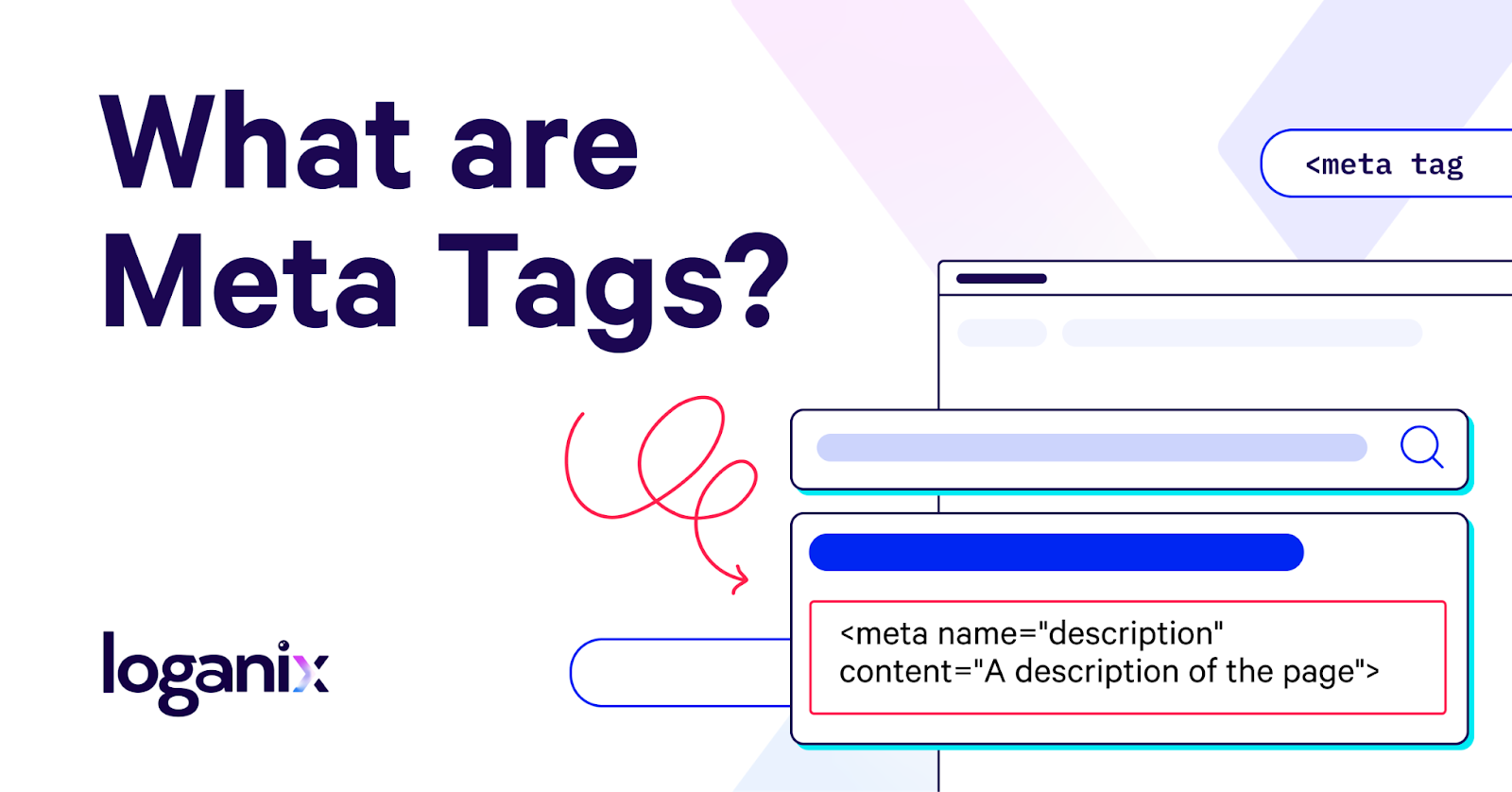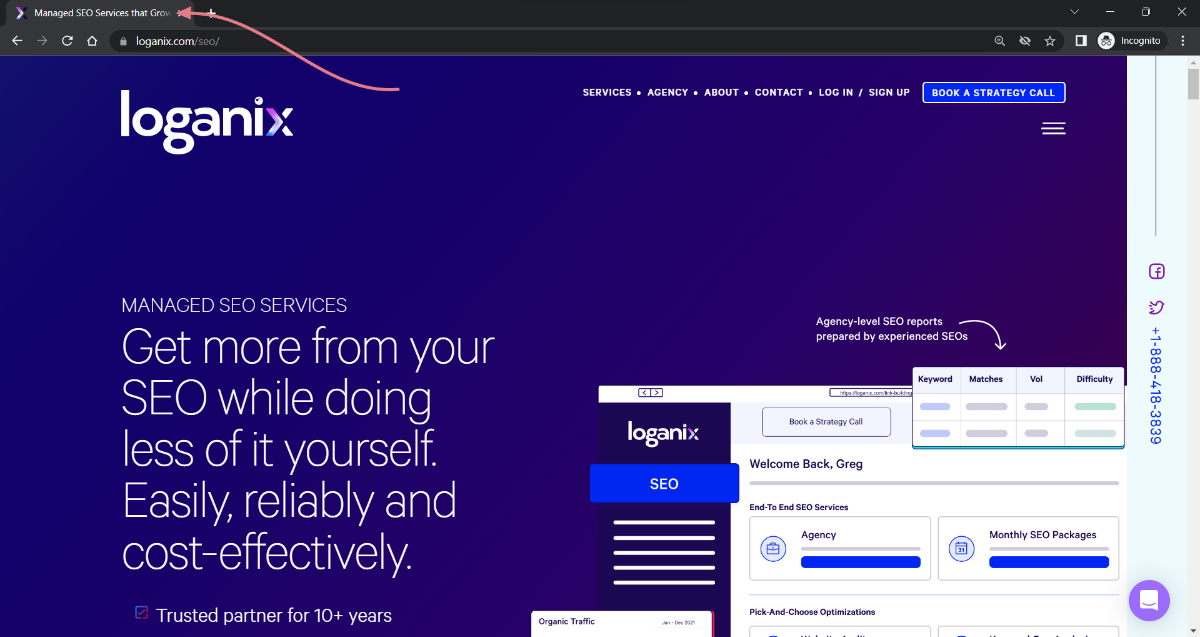What are Meta Tags? Decoding the Power of Web Metadata

Hand off the toughest tasks in SEO, PPC, and content without compromising quality
Explore ServicesMeta tags, when used correctly, have the power to boost a website’s visibility. However, they will quickly become a liability if best practices aren’t followed.
So you don’t tank your site, let’s learn about
- what are meta tags,
- SEO best practices for creating effective meta tags,
- and the diverse types of meta tags and their unique functions.
What Are Meta Tags?
Meta tags, snippets of code nestled within a webpage’s head section, provide critical information about a page to search engines. They manifest in two forms: 1) raw HTML code influencing search engine perception and indexing of a page, and 2) visible on-page elements. A prime example is the title tag, which serves as the webpage’s title in browser tabs and the clickable headline in search results.
Here’s an example of how a meta title tag would look in the source code:

How the same meta title tag looks on the search engine results pages (SERPs):

And on a browser’s tab:

But that’s just scratching the surface. Meta tags also cover various other aspects of a web page—we’ll dive into the different types of meta tags in a couple of sections down. But first, let’s discover why meta tags are so important.
Learn more: Interested in broadening your SEO knowledge even further? Check out our SEO glossary, where we’ve explained over 250+ terms.
Why Are Meta Tags Important?
Different types of meta tags play distinct roles. Some have a direct influence on SEO. Others work to enhance the user’s experience (UX).
This, to be fair, also influences SEO efforts; UX is considered a ranking factor, made clear by algorithmic preferences like Google’s Core Web Vitals.
Let’s flesh out the impacts a touch more.
The Impact of Meta Tags on SEO
Meta tags are one of the elements search engines use to index and understand the context of the published content on a web page. If the content is perceived to be helpful for any given search query, meta tags allow it to surface in relevant searches. This not only amplifies your web presence but can also increase the click-through rate, especially when your meta tags provide engaging and precise page descriptions.
The Influence of Meta Tags on UX
Meta tags also enhance the user experience. For instance, the language tag determines a web page’s language and geographical region, helping to deliver language, dialect, and culture-appropriate content to users worldwide.
The benefits extend to your website’s architecture as well. Meta tags like the viewport tag help create responsive web designs, ensuring your site looks great on all devices, further improving user experience, and bolstering your SEO.
While some elements, like the title tag, work two-fold. We touched on the SEO benefits of title tags. They are displayed as the headline in search engine results and give the user a quick understanding of the web page’s content before they even click. But in the context of UX, title tags also aid users in determining the relevancy of your webpage to their search, saving them time and, in turn, leaving a positive impression.
Understanding Different Types of Meta Tags
Here’s an overview of the most common types of meta tags and their unique roles:
| Meta Tag | Description |
| <meta name=”description” content=”A description of the page”> | Gives a brief overview of the page’s content. This can be shown in search results snippets. |
| <meta name=”robots” content=”…, …”> and <meta name=”googlebot” content=”…, …”> | Directs the actions of all search engine bots or specifically Google’s bot, influencing how they crawl and index the page. |
| <meta name=”google” content=”nositelinkssearchbox”> | Instructs Google not to display a site links search box in the search results for your site. |
| <meta name=”googlebot” content=”notranslate”> | Signals to Google that the page should not be translated. |
| <meta name=”google” content=”nopagereadaloud”> | Prevents Google’s text-to-speech services from reading the page aloud. |
| <meta name=”google-site-verification” content=”…”> | Used to confirm ownership of a site for Google Search Console. |
| <meta http-equiv=”Content-Type” content=”…; charset=…”> and <meta charset=”…”> | Specifies the type of content and character encoding used on the page. |
| <meta name=”viewport” content=”…”> | Controls how the page is displayed on mobile devices, contributing to mobile-friendliness. |
| <meta property=”og:title” content=”…”> | Sets the title to be used when the page’s content is shared on social media platforms. |
| <meta property=”og:description” content=”…”> | Sets the description to be used when the page’s content is shared on social media platforms. |
| <meta property=”og:image” content=”…”> | Defines the image to be displayed when the page’s content is shared on social media platforms. |
| <meta property=”og:url” content=”…”> | Sets the preferred URL to be used when the page’s content is shared on social media. |
| <meta name=”twitter:card” content=”…”> | Controls how your content appears when shared on Twitter. |
| <meta name=”twitter:creator” content=”…”> | Allows you to associate a Twitter username with the content when it’s shared on Twitter. |
| <meta name=”theme-color” content=”…”> | Changes the color of the browser toolbar or may affect the color of the search bar in mobile search results. |
The Balance of SEO and Meta Tags
Like most things that pertain to SEO, meta tags are best used in a balanced way. So, while these snippets of HTML code are vital for communicating with search engines and improving UX, their misuse can lead to some undesirable consequences.
For instance, while it may be tempting to cram your title tags and meta descriptions with target keywords and slight variations of them, such tactics, known as “keyword stuffing,” could do the opposite of your intentions—harm your SEO efforts, not help them. You see, modern search engines like Google have become increasingly adept at recognizing and, if the misdemeanor is perceived as egregious enough, will actively penalize this type of manipulative behavior.
So rather than risk penalization, your meta tags—particularly your title tags and meta descriptions—should accurately reflect the content of your page, with keywords used naturally and sparingly. This approach not only pleases search engines but also provides a better user experience, ultimately contributing positively to your SEO efforts.
Conclusion
Mastering meta tags and other SEO elements can be complex, especially if you’re juggling the responsibilities of running a business. That’s where Loganix, yep, us, come in. We’re here to help you navigate the complexities of SEO so you can focus on what you do best: running a successful business.
🚀 Get started with our SEO services today, and let’s turn your website into a search results superstar. 🚀
Hand off the toughest tasks in SEO, PPC, and content without compromising quality
Explore ServicesWritten by Brody Hall on October 5, 2023
Content Marketer and Writer at Loganix. Deeply passionate about creating and curating content that truly resonates with our audience. Always striving to deliver powerful insights that both empower and educate. Flying the Loganix flag high from Down Under on the Sunshine Coast, Australia.





